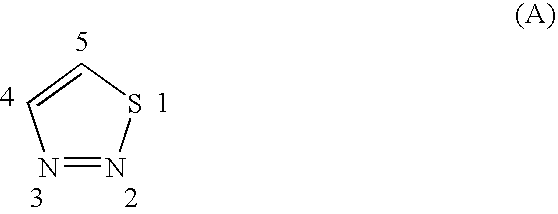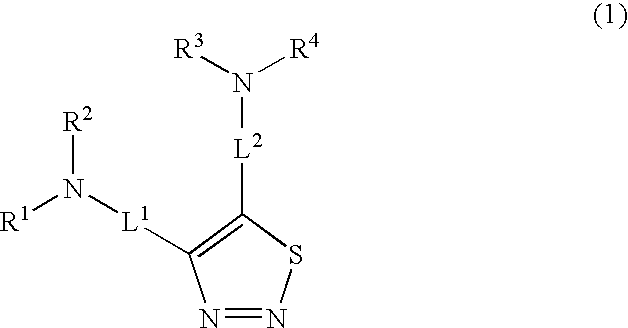Antiproliferative 1,2,3-thiadiazole compounds
a technology of thiadiazole and compound, which is applied in the field of antiproliferative 1, 2, 3thiadiazole compounds, can solve the problems of failure to undergo appropriate cell death, lose the normal regulatory control of cell division, and fail to set up a functional apoptotic machinery
- Summary
- Abstract
- Description
- Claims
- Application Information
AI Technical Summary
Benefits of technology
Problems solved by technology
Method used
Image
Examples
example 1
In Vitro Screen
[0126]Compounds are screened using a series of disease related kinase targets, such as integrin linked kinase-1. Synthesized libraries of compounds are tested against each of the targets to find compounds that inhibit one of the targets preferentially. The desired in vitro potency of the inhibitor is such that the compound is useful as a therapeutic agent, i.e. in the nanomolar or micromolar range.
[0127]Inhibition of the targets is measured by scintillation counting; the incorporation of radioactive phosphate onto a specific substrate which is immobilized onto a filter paper at the end of the assay. To provide meaningful measurements of inhibition, the assays are performed both in the absence and presence of specific and known inhibitors, and the amount of incorporated radioactivity is compared to provide a baseline measurement.
[0128]The baseline activity is the amount of radioactivity incorporated in the absence of inhibitor. The amount of radioactivity incorporated ...
example 2
Inhibition of Angiogenesis
[0140]The test compounds were tested in several angiogenesis related assays. Angiogenesis is an important component of tumour growth and inflammation, and for this reason was deemed a descriptive model. Endothelial proliferation, thymidine incorporation proliferation, invasion and chick chorioallantoic membrane (“CAM”) were models used.
Materials and Methods
[0141]Endothelial cell cultures: Cell lines used include HUVEC, EJG and MS1 and are routinely passaged 1 to 2 times weekly. Endothelial growth media (EGM) consists of Endothelial Base Media plus all supplements (Clonetics). For testing of compounds, endothelial cells were plated on 1% gelatin-coated plates. Prior to plating, gelatin solution was added to the plates for at least 10 minutes before plating, but excess solution removed immediately before adding cells. Sterile gelatin solution consists of 1% gelatin in dH2O that has been autoclaved. Endothelial cells form a characteristic cobblestone monolayer...
example 3
Assessment of Inhibitor Effects on Cell Viability
[0158]Two assays (MTT and 3H-thymidine incorporation) were performed at one concentration to screen for cellular toxicity, and were followed up with a third assay (Caspase-3) on compounds that had cytotoxic effects, to determine the mechanism of death, either necrosis or apoptosis. Apoptosis is an important indicator of a potential therapeutic agent for treating hyperproliferative disease, such as cancer and precancerous conditions. In addition, inflammation, as well as angiogenesis, can be linked to a suppression of apoptosis. Inflammation results from proliferation of immune cells (T-cells, macrophages, neutrophils, etc), particularly immune cells producing pro-inflammatory cytokines, and results in increased vascularization of the affected area. Inducing apoptosis in immune cells and inhibiting angiogenesis combats the processes contributing to of inflammatory disease.
[0159]Each experiment was done 3 times, with 8 well replicates e...
PUM
| Property | Measurement | Unit |
|---|---|---|
| Molar density | aaaaa | aaaaa |
| Molar density | aaaaa | aaaaa |
| Fraction | aaaaa | aaaaa |
Abstract
Description
Claims
Application Information
 Login to View More
Login to View More - R&D
- Intellectual Property
- Life Sciences
- Materials
- Tech Scout
- Unparalleled Data Quality
- Higher Quality Content
- 60% Fewer Hallucinations
Browse by: Latest US Patents, China's latest patents, Technical Efficacy Thesaurus, Application Domain, Technology Topic, Popular Technical Reports.
© 2025 PatSnap. All rights reserved.Legal|Privacy policy|Modern Slavery Act Transparency Statement|Sitemap|About US| Contact US: help@patsnap.com



